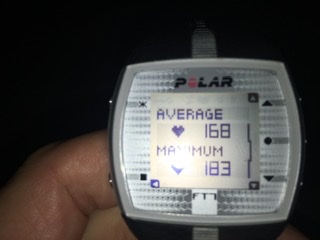Everyone is different, both innately and through training emphasis - I was just giving some broad indicators.
Running will typically higher - when I was measured in the lab a few years ago my run levels were 10bpm higher than my cycling.
I had a look back at some of my recent runs, I ran a HM race in 1:31 at 169 bpm last year, ran a training HM 1:26 at 157bpm in April and ran 1:31 in a IM70.3 St Polten at 159bpm.
Based on my 10k efforts, I could probably run 1:22-1:23 now at 168bpm
My LTR is around 169/170 BPM which is around 90% of me MHR, but I am comfortable at 158/159 bpm - around 85% of my MHR. Most of my run training is at an average sub 150bpm, with around 75-80% of the time below 150, will often stray above on hills for short periods. Hard runs are at an average over 160 with short periods up to 180
The hardest runs are the long (16-20km) fasted runs, just getting my HR up to 150 is a challenge
My running and cycling HR is pretty similar
This is really a timely reminder for me to rein-it-in on my long runs; I’m doing them at too higher HR. I blame the GPS era. I was at my best 2008-13 before I went GPS - I just ran to HR, and didn’t really know what sort of pace that was, it was just on feel. Now with GPS (and Strava), the ego can get involved - and that’s a bad thing.
Matthew_Spooner you are really flying, it’s good to see & will be watching closely for your IM performance.
I have been aware of the 80:20 concept for ages, but have found it a tough one to internalise. It takes patience and counter-intuition to hold back on the 80%. And some real planning and concentration to nail the 20%. Guess I never had much patience or concentration in my 20s and 30s and so probably did most training somewhere in the middle.
Matt Fitzgerald, Don Fink, Maffetone, Gordo Bryn etc etc can’t all be wrong.
Get a dog. They really help you to run slow
Its not actually 80/20 though , more like 90/10. the 80/20 is based on sessions so 4 easy 1 hard . That 1 hard with be half and half hard intervals and easy recovery.
I wont go into the sports science stuff and how thresholds are usually not understood but there are 2 thresholds, the easy needs to be below the first (conversational pace) the hard above the 2nd. (> FTP in bike terms) . I generally like to include work at VO2 max and also neuromuscular adaptation through very high (think sub 7sec intervals using largely the alactic energy system.) I also like increasing pace work ie where the last 15 minutes of a long run are at your best effort. so the 90/10 doesn’t even mean he 10% in a single session, its can be spread. With swimming i like to add intensity in most sessions of some sort whether that’s through IM work or things like 12.5m sprints. As always its not one size fits all and with this the less you train the more intensity you could get away with doing. If you only do 5 hours a week you may want to do more than 30 minutes of hard work to elicit the adaptations or you will be barely staying fit.
Found this on Slowtwtich,worth a watch if a bit long
https://lecturecapture.brookes.ac.uk/Mediasite/Play/8c0f98ec83c44ec6aa98ca199d2defb51d
That’s when it started working for me…yes, the low intensity needs to be low, but when I started to really really suffer in the hard sessions… suddenly, I was riding comfortable steady state at power levels that would have been really tough a few months previously…I think previously I’d worked hard, but not absolutely ‘fried’ myself in the hard sessions… applies (for me at least) to both bike and run.
Works for sure.
This was the 20 today…
As others have said the 80% needs to be fairly easy, build the engine…
More sustainable too. 
It really does work, zwifting really pushes me harder than I would ever ride normally, however, the increase in performance in the real world is amazing, as I discovered last saturday